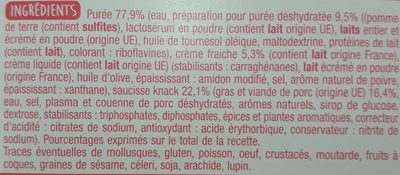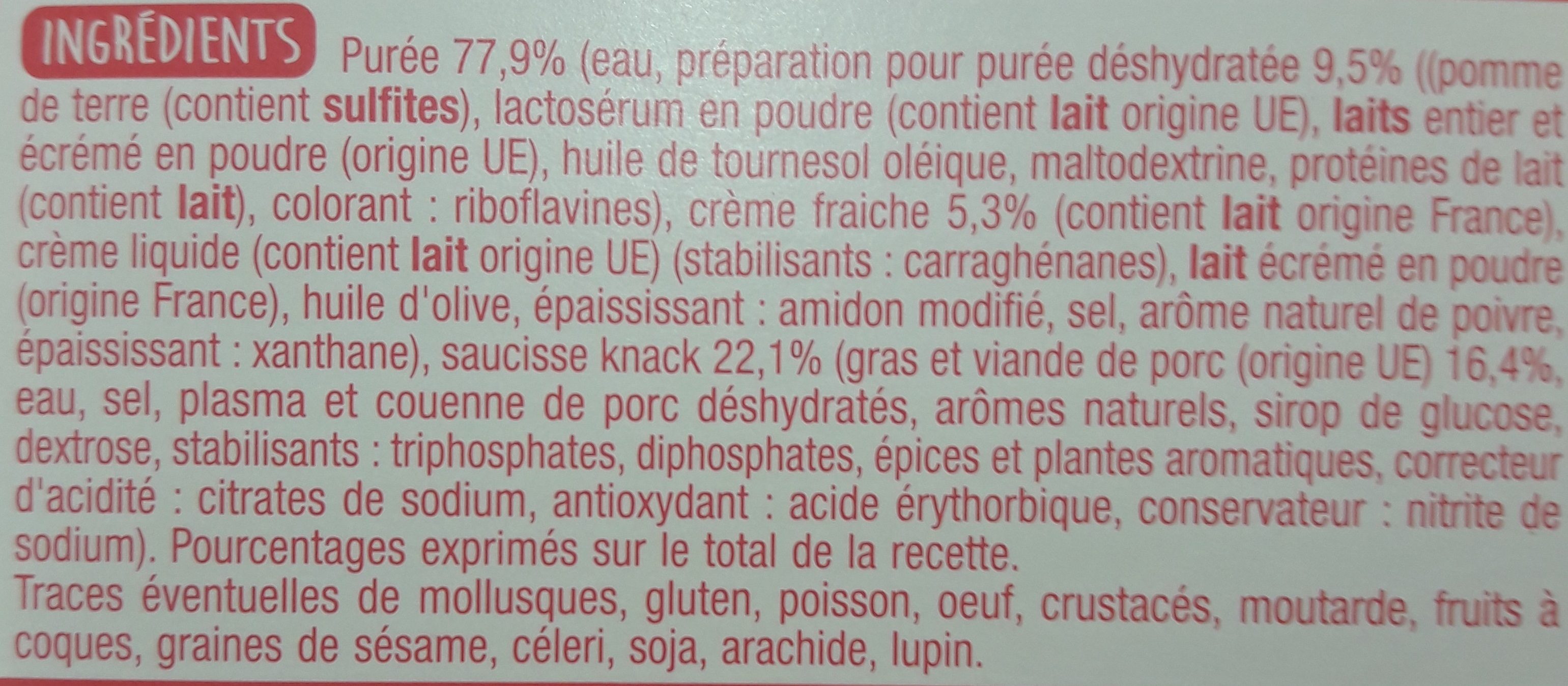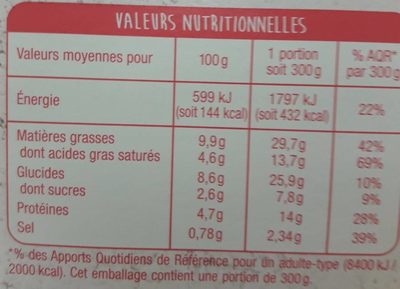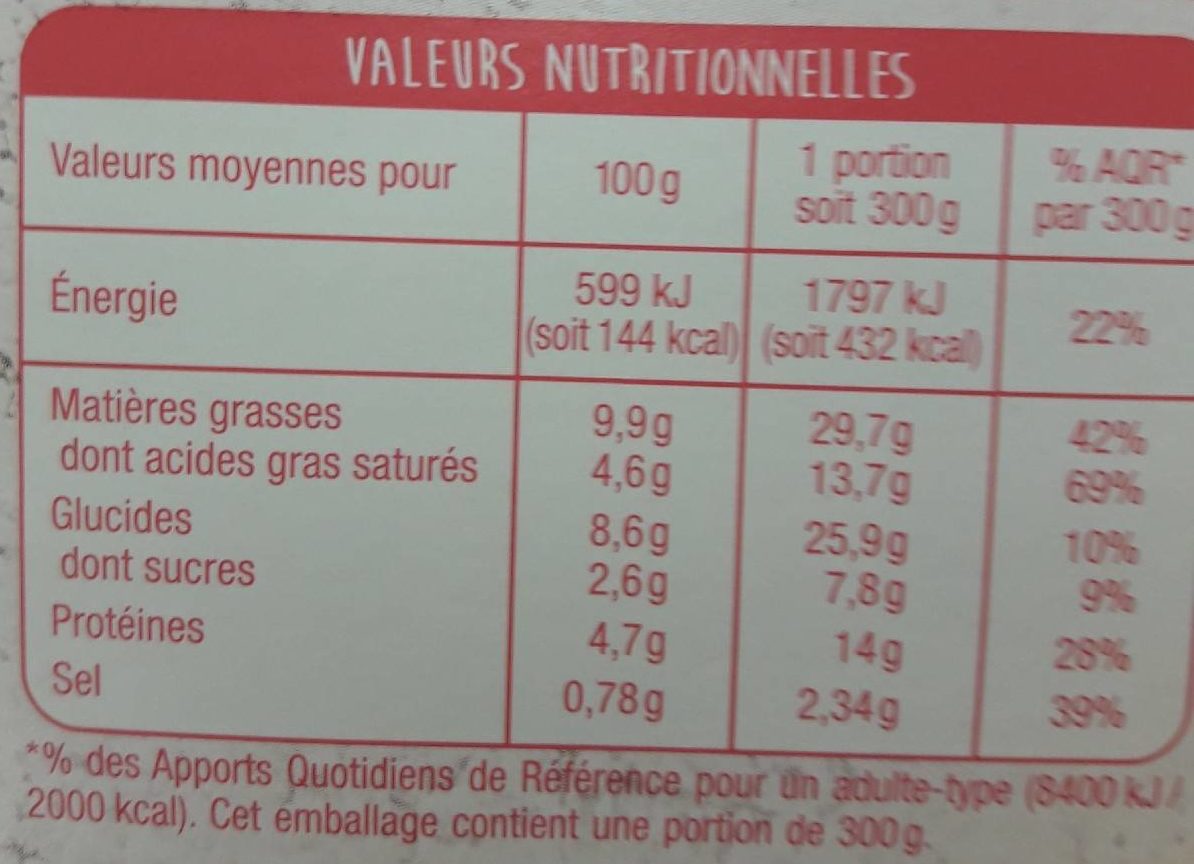Help us make food transparency the norm!
As a non-profit organization, we depend on your donations to continue informing consumers around the world about what they eat.
The food revolution starts with you!
Knack Purée - Auchan - 300 g
Knack Purée - Auchan - 300 g
Important note: this product is no longer sold. The data is kept for reference only. This product does not appear in regular searches and is not taken into account for statistics. (Withdrawal date: 2023/07/01)
This product page is not complete. You can help to complete it by editing it and adding more data from the photos we have, or by taking more photos using the app for Android or iPhone/iPad. Thank you!
×
Some of the data for this product has been provided directly by the manufacturer AUCHAN APAW.
Barcode: 3596710439263 (EAN / EAN-13)
Quantity: 300 g
Packaging: Plastic, Cardboard, Fresh
Brands: Auchan
Categories: Meats and their products, Meals, Meals with meat, Pork meals, Refrigerated foods, Microwave meals, Refrigerated meals
Labels, certifications, awards:
No artificial flavors, Green Dot, In braille
Origin of ingredients: France, European Union
Traceability code: FR 44.131.008 CE - Pornic (Loire-Atlantique, France)
Stores: Auchan
Countries where sold: France
Matching with your preferences
Health
Ingredients
-
39 ingredients
: Purée 77,9 % (eau, préparation pour purée déshydratée de terre (contient sulfites), lactosérum en poudre (contient lait origine UE), laits entier et écrémé en poudre (origine UE), huile de tournesol oléique, maltodextrine, protéines de lait (contient lait), colorant : riboflavines), crème fraiche 5,3 % (contient lait origine France), crème liquide (contient lait origine UE) (stabilisants : carraghénanes), lait écrémé en poudre (origine France), huile d'olive, épaississant : amidon modifié, sel, arôme naturel de épaississant : xanthane), saucisse knack 22,1 % (gras et viande de porc (origine UE) 16,4 % eau, sel, plasma et couenne de porc déshydratés, arômes naturels, sirop de glucose, dextrose, stabilisants : triphosphates, diphosphates, épices et plantes aromatiques, correcteur d'acidité : citrates de sodium, antioxydant : acide érythorbique, conservateur : nitrite de sodium).Allergens: Milk, Sulphur dioxide and sulphitesTraces: Celery, Crustaceans, Eggs, Fish, Gluten, Lupin, Molluscs, Mustard, Nuts, Peanuts, Sesame seeds, Soybeans
Food processing
-
Ultra processed foods
Elements that indicate the product is in the 4 - Ultra processed food and drink products group:
- Additive: E101 - Riboflavin
- Additive: E14XX - Modified Starch
- Additive: E407 - Carrageenan
- Additive: E415 - Xanthan gum
- Additive: E450 - Diphosphates
- Additive: E451 - Triphosphates
- Ingredient: Colour
- Ingredient: Dextrose
- Ingredient: Flavouring
- Ingredient: Glucose
- Ingredient: Glucose syrup
- Ingredient: Maltodextrin
- Ingredient: Milk proteins
- Ingredient: Thickener
- Ingredient: Whey
Food products are classified into 4 groups according to their degree of processing:
- Unprocessed or minimally processed foods
- Processed culinary ingredients
- Processed foods
- Ultra processed foods
The determination of the group is based on the category of the product and on the ingredients it contains.
Additives
-
E101 - Riboflavin
Riboflavin: Riboflavin, also known as vitamin B2, is a vitamin found in food and used as a dietary supplement. Food sources include eggs, green vegetables, milk and other dairy product, meat, mushrooms, and almonds. Some countries require its addition to grains. As a supplement it is used to prevent and treat riboflavin deficiency and prevent migraines. It may be given by mouth or injection.It is nearly always well tolerated. Normal doses are safe during pregnancy. Riboflavin is in the vitamin B group. It is required by the body for cellular respiration.Riboflavin was discovered in 1920, isolated in 1933, and first made in 1935. It is on the World Health Organization's List of Essential Medicines, the most effective and safe medicines needed in a health system. Riboflavin is available as a generic medication and over the counter. In the United States a month of supplements costs less than 25 USD.Source: Wikipedia
-
E101i - Riboflavin
Riboflavin: Riboflavin, also known as vitamin B2, is a vitamin found in food and used as a dietary supplement. Food sources include eggs, green vegetables, milk and other dairy product, meat, mushrooms, and almonds. Some countries require its addition to grains. As a supplement it is used to prevent and treat riboflavin deficiency and prevent migraines. It may be given by mouth or injection.It is nearly always well tolerated. Normal doses are safe during pregnancy. Riboflavin is in the vitamin B group. It is required by the body for cellular respiration.Riboflavin was discovered in 1920, isolated in 1933, and first made in 1935. It is on the World Health Organization's List of Essential Medicines, the most effective and safe medicines needed in a health system. Riboflavin is available as a generic medication and over the counter. In the United States a month of supplements costs less than 25 USD.Source: Wikipedia
-
E250 - Sodium nitrite
Sodium nitrite: Sodium nitrite is the inorganic compound with the chemical formula NaNO2. It is a white to slightly yellowish crystalline powder that is very soluble in water and is hygroscopic. It is a useful precursor to a variety of organic compounds, such as pharmaceuticals, dyes, and pesticides, but it is probably best known as a food additive to prevent botulism. It is on the World Health Organization's List of Essential Medicines, the most important medications needed in a basic health system.Nitrate or nitrite -ingested- under conditions that result in endogenous nitrosation has been classified as "probably carcinogenic to humans" by International Agency for Research on Cancer -IARC-.Source: Wikipedia
-
E315 - Erythorbic acid
Erythorbic acid: Erythorbic acid -isoascorbic acid, D-araboascorbic acid- is a stereoisomer of ascorbic acid -vitamin C-. It is synthesized by a reaction between methyl 2-keto-D-gluconate and sodium methoxide. It can also be synthesized from sucrose or by strains of Penicillium that have been selected for this feature. It is denoted by E number E315, and is widely used as an antioxidant in processed foods.Clinical trials have been conducted to investigate aspects of the nutritional value of erythorbic acid. One such trial investigated the effects of erythorbic acid on vitamin C metabolism in young women; no effect on vitamin C uptake or clearance from the body was found. A later study found that erythorbic acid is a potent enhancer of nonheme-iron absorption.Since the U.S. Food and Drug Administration banned the use of sulfites as a preservative in foods intended to be eaten fresh -such as salad bar ingredients-, the use of erythorbic acid as a food preservative has increased. It is also used as a preservative in cured meats and frozen vegetables.It was first synthesized in 1933 by the German chemists Kurt Maurer and Bruno Schiedt.Source: Wikipedia
-
E331 - Sodium citrates
Sodium citrate: Sodium citrate may refer to any of the sodium salts of citrate -though most commonly the third-: Monosodium citrate Disodium citrate Trisodium citrateThe three forms of the salt are collectively known by the E number E331. Sodium citrates are used as acidity regulators in food and drinks, and also as emulsifiers for oils. They enable cheeses to melt without becoming greasy.Source: Wikipedia
-
E407 - Carrageenan
Carrageenan (E407), derived from red seaweed, is widely employed in the food industry as a gelling, thickening, and stabilizing agent, notably in dairy and meat products.
It can exist in various forms, each imparting distinct textural properties to food.
However, its degraded form, often referred to as poligeenan, has raised health concerns due to its potential inflammatory effects and its classification as a possible human carcinogen (Group 2B) by the International Agency for Research on Cancer (IARC).
Nevertheless, food-grade carrageenan has been deemed safe by various regulatory bodies when consumed in amounts typically found in food.
-
E415 - Xanthan gum
Xanthan gum (E415) is a natural polysaccharide derived from fermented sugars, often used in the food industry as a thickening and stabilizing agent.
This versatile food additive enhances texture and prevents ingredient separation in a wide range of products, including salad dressings, sauces, and gluten-free baked goods.
It is considered safe for consumption even at high intake amounts.
-
E450 - Diphosphates
Diphosphates (E450) are food additives often utilized to modify the texture of products, acting as leavening agents in baking and preventing the coagulation of canned food.
These salts can stabilize whipped cream and are also found in powdered products to maintain their flow properties. They are commonly present in baked goods, processed meats, and soft drinks.
Derived from phosphoric acid, they're part of our daily phosphate intake, which often surpasses recommended levels due to the prevalence of phosphates in processed foods and drinks.
Excessive phosphate consumption is linked to health issues, such as impaired kidney function and weakened bone health. Though diphosphates are generally regarded as safe when consumed within established acceptable daily intakes, it's imperative to monitor overall phosphate consumption to maintain optimal health.
-
E451 - Triphosphates
Sodium triphosphate: Sodium triphosphate -STP-, also sodium tripolyphosphate -STPP-, or tripolyphosphate -TPP-,- is an inorganic compound with formula Na5P3O10. It is the sodium salt of the polyphosphate penta-anion, which is the conjugate base of triphosphoric acid. It is produced on a large scale as a component of many domestic and industrial products, especially detergents. Environmental problems associated with eutrophication are attributed to its widespread use.Source: Wikipedia
Ingredients analysis
-
Palm oil content unknown
Unrecognized ingredients: fr:preparation-pour-puree-deshydratee-de-terre, fr:laits-entier-et-ecreme-en-poudre, fr:arome-naturel-de-epaississant, fr:saucisse-knack, fr:gras-et-viande-de-porc, fr:plasma-et-couenne-de-porc-deshydratesSome ingredients could not be recognized.
We need your help!
You can help us recognize more ingredients and better analyze the list of ingredients for this product and others:
- Edit this product page to correct spelling mistakes in the ingredients list, and/or to remove ingredients in other languages and sentences that are not related to the ingredients.
- Add new entries, synonyms or translations to our multilingual lists of ingredients, ingredient processing methods, and labels.
If you would like to help, join the #ingredients channel on our Slack discussion space and/or learn about ingredients analysis on our wiki. Thank you!
-
Non-vegan
Non-vegan ingredients: Whey powder, Milk proteins, Fresh cream, Single cream, Skimmed milk powderSome ingredients could not be recognized.
We need your help!
You can help us recognize more ingredients and better analyze the list of ingredients for this product and others:
- Edit this product page to correct spelling mistakes in the ingredients list, and/or to remove ingredients in other languages and sentences that are not related to the ingredients.
- Add new entries, synonyms or translations to our multilingual lists of ingredients, ingredient processing methods, and labels.
If you would like to help, join the #ingredients channel on our Slack discussion space and/or learn about ingredients analysis on our wiki. Thank you!
-
Vegetarian status unknown
Unrecognized ingredients: fr:preparation-pour-puree-deshydratee-de-terre, fr:laits-entier-et-ecreme-en-poudre, fr:arome-naturel-de-epaississant, fr:saucisse-knack, fr:gras-et-viande-de-porc, fr:plasma-et-couenne-de-porc-deshydratesSome ingredients could not be recognized.
We need your help!
You can help us recognize more ingredients and better analyze the list of ingredients for this product and others:
- Edit this product page to correct spelling mistakes in the ingredients list, and/or to remove ingredients in other languages and sentences that are not related to the ingredients.
- Add new entries, synonyms or translations to our multilingual lists of ingredients, ingredient processing methods, and labels.
If you would like to help, join the #ingredients channel on our Slack discussion space and/or learn about ingredients analysis on our wiki. Thank you!
-
Details of the analysis of the ingredients
We need your help!
Some ingredients could not be recognized.
We need your help!
You can help us recognize more ingredients and better analyze the list of ingredients for this product and others:
- Edit this product page to correct spelling mistakes in the ingredients list, and/or to remove ingredients in other languages and sentences that are not related to the ingredients.
- Add new entries, synonyms or translations to our multilingual lists of ingredients, ingredient processing methods, and labels.
If you would like to help, join the #ingredients channel on our Slack discussion space and/or learn about ingredients analysis on our wiki. Thank you!
: Purée 77.9% (eau, préparation pour purée déshydratée de terre, _lactosérum_ en poudre (), _laits_ entier et écrémé en poudre, huile de tournesol oléique, maltodextrine, protéines de _lait_, colorant (riboflavines)), _crème_ fraiche 5.3% (), crème liquide (stabilisants (carraghénanes)), _lait_ écrémé en poudre, huile d'olive, épaississant (amidon modifié), sel, arôme naturel de épaississant (xanthane), saucisse knack 22.1% (gras et viande de porc, eau 16.4%, sel, plasma et couenne de porc déshydratés, arômes naturels, sirop de glucose, dextrose, stabilisants (triphosphates), diphosphates, épices et plantes aromatiques, correcteur d'acidité (citrates de sodium), antioxydant (acide érythorbique), conservateur (nitrite de sodium))- Purée -> en:puree - vegan: ignore - vegetarian: ignore - percent: 77.9
- eau -> en:water - vegan: yes - vegetarian: yes - ciqual_food_code: 18066
- préparation pour purée déshydratée de terre -> fr:preparation-pour-puree-deshydratee-de-terre
- _lactosérum_ en poudre -> en:whey-powder - vegan: no - vegetarian: maybe
- _laits_ entier et écrémé en poudre -> fr:laits-entier-et-ecreme-en-poudre
- huile de tournesol oléique -> en:high-oleic-sunflower-oil - vegan: yes - vegetarian: yes - from_palm_oil: no - ciqual_food_code: 17440
- maltodextrine -> en:maltodextrin - vegan: yes - vegetarian: yes
- protéines de _lait_ -> en:milk-proteins - vegan: no - vegetarian: yes
- colorant -> en:colour
- riboflavines -> en:e101 - vegan: maybe - vegetarian: yes
- _crème_ fraiche -> en:fresh-cream - vegan: no - vegetarian: yes - percent: 5.3
- crème liquide -> en:single-cream - vegan: no - vegetarian: yes
- stabilisants -> en:stabiliser
- carraghénanes -> en:e407 - vegan: yes - vegetarian: yes
- stabilisants -> en:stabiliser
- _lait_ écrémé en poudre -> en:skimmed-milk-powder - vegan: no - vegetarian: yes - ciqual_food_code: 19054
- huile d'olive -> en:olive-oil - vegan: yes - vegetarian: yes - from_palm_oil: no
- épaississant -> en:thickener
- amidon modifié -> en:modified-starch - vegan: yes - vegetarian: yes
- sel -> en:salt - vegan: yes - vegetarian: yes - ciqual_food_code: 11058
- arôme naturel de épaississant -> fr:arome-naturel-de-epaississant
- xanthane -> en:e415 - vegan: yes - vegetarian: yes
- saucisse knack -> fr:saucisse-knack - percent: 22.1
- gras et viande de porc -> fr:gras-et-viande-de-porc
- eau -> en:water - vegan: yes - vegetarian: yes - ciqual_food_code: 18066 - percent: 16.4
- sel -> en:salt - vegan: yes - vegetarian: yes - ciqual_food_code: 11058
- plasma et couenne de porc déshydratés -> fr:plasma-et-couenne-de-porc-deshydrates
- arômes naturels -> en:natural-flavouring - vegan: maybe - vegetarian: maybe
- sirop de glucose -> en:glucose-syrup - vegan: yes - vegetarian: yes
- dextrose -> en:dextrose - vegan: yes - vegetarian: yes
- stabilisants -> en:stabiliser
- triphosphates -> en:e451 - vegan: yes - vegetarian: yes
- diphosphates -> en:e450 - vegan: yes - vegetarian: yes
- épices et plantes aromatiques -> en:herbs-and-spices - vegan: yes - vegetarian: yes
- correcteur d'acidité -> en:acidity-regulator
- citrates de sodium -> en:e331 - vegan: yes - vegetarian: yes
- antioxydant -> en:antioxidant
- acide érythorbique -> en:e315 - vegan: yes - vegetarian: yes
- conservateur -> en:preservative
- nitrite de sodium -> en:e250 - vegan: yes - vegetarian: yes
Nutrition
-
Average nutritional quality
⚠ ️Warning: the amount of fiber is not specified, their possible positive contribution to the grade could not be taken into account.⚠ ️Warning: the amount of fruits, vegetables and nuts is not specified on the label, it was estimated from the list of ingredients: 0This product is not considered a beverage for the calculation of the Nutri-Score.
Positive points: 2
- Proteins: 2 / 5 (value: 4.7, rounded value: 4.7)
- Fiber: 0 / 5 (value: 0, rounded value: 0)
- Fruits, vegetables, nuts, and colza/walnut/olive oils: 0 / 5 (value: 0, rounded value: 0)
Negative points: 8
- Energy: 1 / 10 (value: 602, rounded value: 602)
- Sugars: 0 / 10 (value: 2.6, rounded value: 2.6)
- Saturated fat: 4 / 10 (value: 4.6, rounded value: 4.6)
- Sodium: 3 / 10 (value: 312, rounded value: 312)
The points for proteins are counted because the negative points are less than 11.
Nutritional score: 6 (8 - 2)
Nutri-Score: C
-
Nutrient levels
-
Fat in moderate quantity (9.9%)
What you need to know- A high consumption of fat, especially saturated fats, can raise cholesterol, which increases the risk of heart diseases.
Recommendation: Limit the consumption of fat and saturated fat- Choose products with lower fat and saturated fat content.
-
Saturated fat in moderate quantity (4.6%)
What you need to know- A high consumption of fat, especially saturated fats, can raise cholesterol, which increases the risk of heart diseases.
Recommendation: Limit the consumption of fat and saturated fat- Choose products with lower fat and saturated fat content.
-
Sugars in low quantity (2.6%)
What you need to know- A high consumption of sugar can cause weight gain and tooth decay. It also augments the risk of type 2 diabetes and cardio-vascular diseases.
Recommendation: Limit the consumption of sugar and sugary drinks- Sugary drinks (such as sodas, fruit beverages, and fruit juices and nectars) should be limited as much as possible (no more than 1 glass a day).
- Choose products with lower sugar content and reduce the consumption of products with added sugars.
-
Salt in moderate quantity (0.78%)
What you need to know- A high consumption of salt (or sodium) can cause raised blood pressure, which can increase the risk of heart disease and stroke.
- Many people who have high blood pressure do not know it, as there are often no symptoms.
- Most people consume too much salt (on average 9 to 12 grams per day), around twice the recommended maximum level of intake.
Recommendation: Limit the consumption of salt and salted food- Reduce the quantity of salt used when cooking, and don't salt again at the table.
- Limit the consumption of salty snacks and choose products with lower salt content.
-
-
Nutrition facts
Nutrition facts As sold
for 100 g / 100 mlAs sold
per serving (300 g)Compared to: Refrigerated meals Energy 602 kj
(144 kcal)1,810 kj
(432 kcal)-17% Fat 9.9 g 29.7 g +14% Saturated fat 4.6 g 13.8 g +74% Carbohydrates 8.6 g 25.8 g -41% Sugars 2.6 g 7.8 g +19% Fiber ? ? Proteins 4.7 g 14.1 g -33% Salt 0.78 g 2.34 g -23% Fruits‚ vegetables‚ nuts and rapeseed‚ walnut and olive oils (estimate from ingredients list analysis) 0 % 0 %
Environment
-
Eco-Score not computed - Unknown environmental impact
We could not compute the Eco-Score of this product as it is missing some data, could you help complete it?Could you add a precise product category so that we can compute the Eco-Score? Add a category
Packaging
-
Packaging with a medium impact
-
Packaging parts
(Plastic)
(Cardboard)
-
Packaging materials
Material % Packaging weight Packaging weight per 100 g of product Paper or cardboard Plastic Total
-
Transportation
-
Origins of ingredients
Origins of ingredients with a high impact
Origin of the product and/or its ingredients % of ingredients Impact European Union 43 %High France 42 %Medium
Report a problem
-
Incomplete or incorrect information?
Category, labels, ingredients, allergens, nutritional information, photos etc.
If the information does not match the information on the packaging, please complete or correct it. Open Food Facts is a collaborative database, and every contribution is useful for all.
Data sources
Product added on by kiliweb
Last edit of product page on by org-auchan-apaw.
Product page also edited by beniben, manu1400, openfoodfacts-contributors, packbot, tacite, yuka.WGFKWUlxSWZpK0lsdE5vODFSbjAxczFFeThXSGNFKzhCTFVvSVE9PQ.










